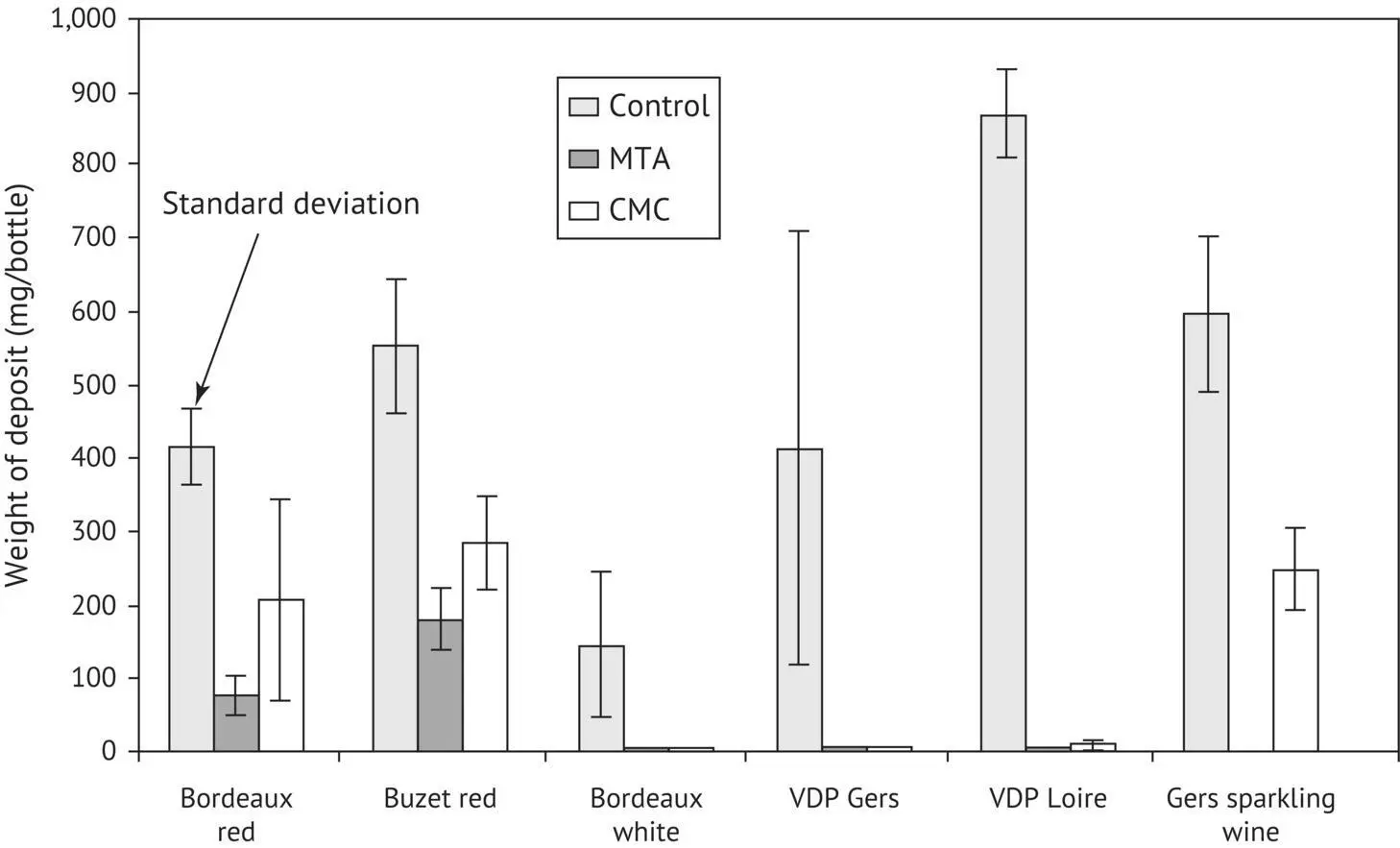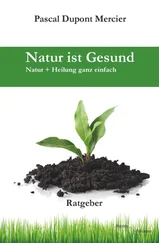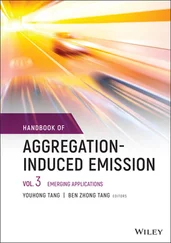
FIGURE 1.23 Structure of a carboxymethylcellulose (CMC) chain.

FIGURE 1.24 Formula for the etherification of celluloses (R–[OH] 3) by sodium chloroacetate.
CMCs are also reputed to promote solubilization of proteins and stabilize solutions containing them (Federson and Thorp, 1993). This property is useful in winemaking for the purpose of preventing protein haze. These CMC–protein interactions may be compared with the carbohydrate–protein association in glycoproteins, such as yeast mannoproteins.
TABLE 1.23Treating Various Wines with CMC (Results After One Month at −4°C; See Figure 1.25)
| Wine treated |
Dose of CMC used (g/hl) |
Comments |
| Red A.O.C. Bordeaux |
2 |
Unfiltered |
| Red A.O.C. Buzet |
4 |
Filtered prior to treatment |
| White A.O.C. Bordeaux |
4 |
Fined, treated with CMC, then filtered |
| White vin de pays (Gers) |
4 |
Fined, treated with CMC, then filtered |
| White vin de pays (Loire) |
4 |
Fined, treated with CMC, then filtered |
| Sparkling wine (Gers) |
4 |
Treated prior to second fermentation |
CMCs are available in the form of powder or white granules. As these absorb humidity from the air, they must be stored in a dry place. Their use in winemaking has been authorized in the EU. Recent results (Crachereau et al., 2001) indicate that low‐viscosity CMCs are effective in preventing tartrate crystallization at doses 12–250 times lower than those currently used in the food industry. A dose of 2 g/hl is often ineffective, but it should not exceed 4 g/hl in wines supersaturated with potassium bitartrate. Details of the results are given in Table 1.23and Figure 1.25.
These results demonstrate comparable effectiveness for metatartaric acid (10 g/hl) and CMC (4 g/hl). Furthermore, a comparison of the stability and effectiveness of these two additives, following prolonged heat treatment at 55–60°C for 5–30 days and one month at −4°C, showed that CMC was perfectly heat stable. It was still perfectly effective, whereas metatartaric acid became totally ineffective after only five days at 55–60°C (Peynaud and Guimberteau, 1961; Ribéreau‐Gayon et al ., 1977).

FIGURE 1.25 Comparison of the effectiveness of metatartaric acid and carboxymethylcellulose on turbidity due to tartrate crystals (Crachereau et al ., 2001) (see Table 1.23for treatment conditions).
The effectiveness of CMC is due to its property of significantly reducing the growth rate of crystals: a dose of 2 mg/l reduces crystal growth by a factor of seven (Gerbaud, 1996). CMC also modifies the morphology of potassium bitartrate crystals.
In the case of wines intended for a second fermentation, three different CMCs produced a more stable, persistent bead. Only the CMC with the highest molecular weight caused a slight increase in bubble size. A similar inhibition of crystallization has also been observed in Champagne base wines (A. Maujean, personal communication).
All these positive results, combined with the fact that these CMCs are easy to use, relatively inexpensive, and do not require special investments, led to their authorization for use in winemaking by the OIV in June 2008 within the limit of 10 g/hl or 100 mg/l. Its transposition into European law via EU regulation 606/2009 also authorizes its use in red and rosé wines at the same maximum dose (10 g/hl or 100 mg/l). Tartrate stability in red wines is more difficult to obtain than in white and rosé wines. The effectiveness of the treatment is proportional to the dose of inhibitor used. For wines with medium to high instability, the use of CMC (at 10 g/hl) improves tartrate stability. However, it does not always help obtain total stability after the cold test. Only slightly unstable red wines are stabilized by CMC.
The effectiveness of CMC in tannic red wines, with the most complex colloidal structure, can lead in some cases to a destabilization of the coloring matter. This destabilization often causes an increase in wine turbidity. Consequently, color is lost, and clogging risks appear during filtration. The resulting turbidity, if any, is quite variable depending on the wine in question, the storage time, and the temperature. The intensity of this phenomenon is rather random. Exposure to low temperatures actually seems to increase the magnitude of the problem. Studies are currently being conducted to understand the origins of observed haze problems and to establish the optimal conditions of use.
1 Abgueguen O. and Boulton R. (1993) Am. J. Enol. Vitic., 44, 65.
2 Blouin J. (1982) Œno One, 16, 63.
3 Boulton R. (1982) Rev. Fr. Œnol., 87, 97.
4 Casey J.A. (1988) Aust. Grapegrow. Winemak., 295, 19–22.
5 Champagnol F. (1986) Rev. Fr. Oenol., 104, 26.
6 Chauvet J. and Brechot P. (1982) Sci. Aliment., 2, 495.
7 Crachereau J.C., Gabas N., Blouin J., Hebrard S. and Maujean A. (2001) Bull. OIV, 841–842, 151.
8 Dartiguenave C. (1998) Contribution à la maîtrise de l'acidité par l'étude de l'évolution de la capacité tampon acido‐basique des vins de Champagne au cours de leur élaboration, Thèse de Doctorat, Université de Reims‐Champagne‐Ardenne.
9 Dartiguenave C., Jeandet P. and Maujean A. (2000a) Am. J. Enol. Vitic., 51, 4, 347.
10 Dartiguenave C., Jeandet P. and Maujean A. (2000b) Am. J. Enol. Vitic., 51, 4, 352.
11 Devatine A., Gerbaud V., Gabas N. and Blouin J. (2002) Œno One, 36–32, 77.
12 Devraine J. (1969) Thèse Doctorat ès Sciences, Université de Lille.
13 Dubourdieu D. and Moine‐Ledoux V. (1994) Brevet d'Invention Français 2726284.
14 Dubourdieu D. and Moine‐Ledoux V. (1996) Brevet d'Invention Français 9608187.
15 Dunsford P. and Boulton R. (1981) Am. J. Enol. Vitic., 2, 100.
16 Federson R.L. and Thorp S.N. (1993) Industrial Gums, 3rd edition. Academic Press, London.
17 Gaillard M. and Ratsimba B. (1990) Rev. Fr. Œnol., 123, 11.
18 Genevois L. and Ribéreau‐Gayon J. (1935) Bull. Soc. Chim. Fr., 2, 1286, 87.
19 Gerbaud V. (1996) Détermination de l'état de sursaturation et effet des polysaccharides sur la cristallisation du bitartrate de potassium dans les vins, Thèse de l'Université de Toulouse (I.N.P.)
20 Gomez‐Benitez J. (1993) Am. J. Enol. Vitic., 4, 400.
21 Hochli U. (1997) Œno One, 31, 139.
22 Jackson R.S. (1994) Wine Science. Principles and Applications. Academic Press, San Diego.
23 Kalathenos P., Sutherland J.P. and Roberts T.A. (1995) J. Appl. Bacteriol. 78, 245.
24 Lubbers S., Léger B., Charpentier C. and Feuillat M. (1993) Œno One, 1, 13.
25 Maujean A., Sausy L. and Vallée D. (1985) Rev. Fr. Œnol., 100, 39.
26 Maujean A., Vallée D. and Sausy L. (1986) Rev. Fr. Œnol., 104, 34.
27 Moine‐Ledoux V. and Dubourdieu D. (1995) Ve Symposium international d'œnologie. Tec et Doc, Lavoisier, Paris.
28 Moine‐Ledoux V. and Dubourdieu D. (1999) In VIe Symposium international d'œnologie (Ed A. Lonvaud‐Funel), p. 527. Tec et Doc, Lavoisier, Paris.
Читать дальше















